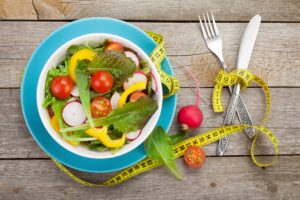 Here at Bel Marra Health we continuously explain to our readers the importance of eating well and a maintaining a balanced diet. We generally give you a few guidelines to follow such as eating more fruits and vegetables, limiting sugar and processed foods and sticking with lean proteins. But there’s more.
Here at Bel Marra Health we continuously explain to our readers the importance of eating well and a maintaining a balanced diet. We generally give you a few guidelines to follow such as eating more fruits and vegetables, limiting sugar and processed foods and sticking with lean proteins. But there’s more.
Not only will understanding how to eat a balanced diet improve your health, but you may see benefits such as weight loss, too. So here is our guide on how to enjoy a balanced diet.
How to enjoy a healthy balanced diet
Advertisement
 The basis of a balanced diet it to ensure you are receiving adequate nutrition – vitamins, minerals, protein, fat etc. The core food groups that contribute to a balanced diet are: Fruits and vegetables, carbohydrates, protein, dairy and fat. Now that we know the category of foods to achieve a balanced diet, let’s explore the importance of each group and how they play a role in our body.
The basis of a balanced diet it to ensure you are receiving adequate nutrition – vitamins, minerals, protein, fat etc. The core food groups that contribute to a balanced diet are: Fruits and vegetables, carbohydrates, protein, dairy and fat. Now that we know the category of foods to achieve a balanced diet, let’s explore the importance of each group and how they play a role in our body.
Protein: Protein is essential for muscle and tissue building, maintenance and recovery. It is even more important in seniors as they are not as physically active and so protein can help maintain muscle. Age, gender, and activity level all play a role in the amount of protein you should consume. The United Stated Department of Agriculture (USDA) recommends women over age 51 eat five ounces of protein and men five and a half ounces of protein.
Fat: Many of us fear fat, but our body needs it. The message here is to choose healthy fats such as mono-saturated or polyunsaturated. These can be found in items such as olive oil, avocados and coconuts. The current problem is many of us consume too much fat of the bad variety. The secret, then, to a balanced diet is to consume fat in moderation and smaller amounts.
Carbohydrates: You probably see “carb-free” diets just about everywhere, but carbohydrates are not the enemy. Our body needs carbohydrates for energy and similar to fat, there are good carbs and bad. Bad carbohydrates are refined and processed whereas good carbohydrates are whole wheat and keep the grain close to their original form. Most people don’t realize this, but vegetables also contain carbohydrates.
Fruits and vegetables: Fruits and vegetables provide us with the bulk of our vitamins and minerals. Some vitamins are water-soluble whereas others are fat soluble. Water-soluble vitamins don’t stay long in the body so we must replenish them daily. These consist of vitamin C and B. Fat-soluble vitamins get stored by the body so you shouldn’t supplement additional vitamins that are fat-soluble. These types of vitamins include vitamin A, D, E and K.
Now let’s explore how much we should eat. Let’s start with the amount of calories the USDA recommends. Senior Americans who are sedentary should consume between 1,800 to 2,200 calories (typically women should stay on the lower end). Active seniors, on the other hand, should consume 2,200 to 3,000 calories as they burn more calories off.
Based on USDA guidelines for a balanced diet (which factors in at least 30 minutes of activity daily) seniors should consume the following:
| Food Category | Men (51+) | Women (51+) |
|---|---|---|
| Fruits | 2 cups | 1.5 cups |
| Vegetables | 2.5 cups | 2 cups |
| Protein | 5.5 ounces | 5 ounces |
| Grains | 3 ounces | 3 ounces |
| Dairy | 3 cups | 3 cups |
| Oils (fat) | 6 teaspoons | 5 teaspoons |
Why is it important to have a balanced diet?
 Now that you are aware of what you should be eating and in what amount, let’s explore the importance of eating a well-balanced diet.
Now that you are aware of what you should be eating and in what amount, let’s explore the importance of eating a well-balanced diet.
Eating a balanced diet is essential for overall good health. By ensuring you are consuming healthy foods and taking in the essential vitamins and minerals you can prevent illness such as heart disease, boost your immune system, control body weight and promote mental wellness. With all this in mind wouldn’t you want to take in the benefits of eating well?
The unfortunate part is that a typical American diet consists of too much fat, too much processed food and way too much sugar. All of this has been linked to promote illness and obesity.
So why send yourself to an early grave when you have the tools to live a long healthy life? It’s as easy as enjoying a well-balanced diet!
Related Reading:
You’re most likely not eating these essential health foods
Most likely, when you were growing up, in school your teachers showed you a food pyramid. Each colored block indicated the recommended serving of each essential food group. Maybe in your earlier years you didn’t have many issues following these guidelines, but it’s probably been a while since you last saw this image. Continue reading…
The addiction most people don’t know they have
We all have that guilty pleasure. Sometimes sweet treats are just too tempting to pass up! It’s okay to enjoy sugary treats in moderation, but if you can’t go a day without a sugary substance, you may be addicted. Continue reading…
Advertisement
Improve digestion and prevent diabetes by eating variety of foods
Have a healthier gut by eating a variety of foods. Find list of gut friendly foods and a Korean dish that can help fight type-2 diabetes and obesity.
Sources:
http://www.choosemyplate.gov/food-groups/grains-amount.pdf
http://www.choosemyplate.gov/food-groups/protein-foods-amount.pdf
http://www.choosemyplate.gov/food-groups/oils-allowance.pdf
http://www.choosemyplate.gov/food-groups/fruits-amount.pdf
http://www.choosemyplate.gov/food-groups/vegetables-amount.pdf
http://www.choosemyplate.gov/food-groups/dairy.html
http://www.newhealthguide.org/Why-Is-It-Important-To-Have-A-Balanced-Diet.html
http://www.healthdirect.gov.au/balanced-diet
http://www.pcdfoundation.org/en/staying-healthy-with-pcd/eat-a-healthy-balanced-diet
http://www.healthline.com/health/balanced-diet#Overview1
